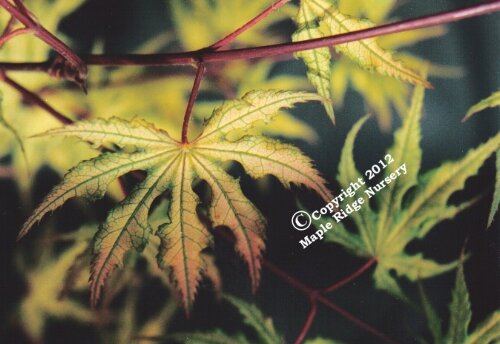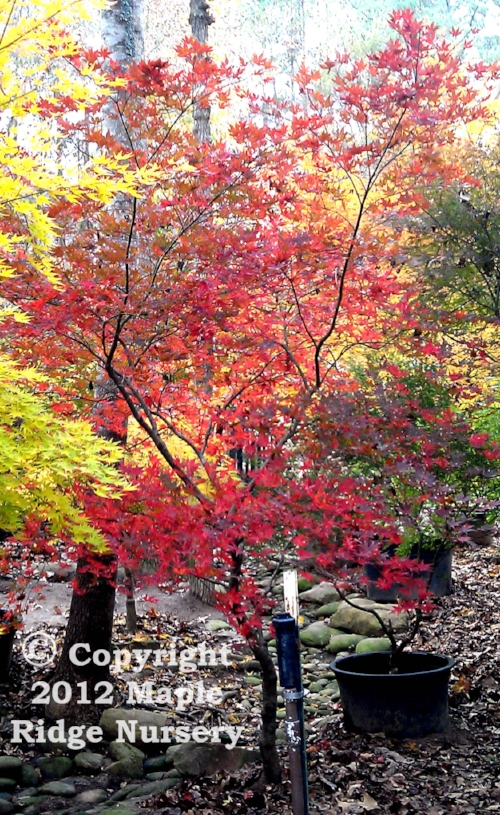Acer palmatum ‘Aka shigitatsu sawa’

Description:
The early spring variegation on this reticulated leaf form of Japanese maple is amazing. Almost the entire leaf will be cream with undertones of red and dark green veins. The leaves will turn green by May but the veins will be slightly darker. 'Aka shigitatsu sawa' will not tolerate afternoon sun in hot climates but should be placed where it can get 3-4 hours of morning sun because light is required to get the red tones to show up. This plant is slow to mature but will turn into a small round topped tree that will be almost as wide as tall.
Synonymous with 'Beni shigitatsu sawa'
10 year size:
Height: 7-9 Feet Width: 5-7 Feet
Acer palmatum ‘Aka shigitatsu sawa’ will grow to be a short tree at maturity never really growing past eight feet tall.
Aka shigitatsu sawa should only get about six feet wide at maturity. This will form a nice round topped tree at maturity.
COLORS:
Acer palmatum ‘Aka shigitatsu sawa’ has creamy white leaves with peach and orange undertone and dark green veins in the spring. This creates a style of variegation called reticulated variegation. This reticulation is prominent in many Japanese maples including the popular “Ghost” series. The leaves will fade to green in the summer, but it still maintains much of the reticulated variegation. Fall color ranges from orange to red.
STRUCTURE:
Acer palmatum ‘Aka shigitatsu sawa’ grows into a small upright tree with a full canopy. Aka shigitatsu sawa is a Japanese maple tree that does not get very big, so it works in just about any location in the garden.
HISTORY:
Acer palmatum ‘Aka shigitatsu sawa’ is the parent tree for many of the reticulated Japanese maple trees. Aka shigitatsu sawa embodies the “ghost” series and all other reticulated Japanese maples with its multiple colored leaves and prominent veining.
HARDINESS:
USDA Plant Hardiness Zones: 5-9
AHS Heat Zone: 5-10
Sunset Climate Zone: 3-10, 12, 14-24, 28-37
Reticulated Japanese maples such as Acer palmatum ‘Aka shigitatsu sawa’ are hardy in most regions of the United States. The only areas where they will not work are areas of extreme cold or extreme hot temperatures. Areas of extremely high altitudes may also not work particularly well for reticulated Japanese maples. Reticulated Japanese maples will also thrive better in areas of consistent rainfall. These zones are general rules, but exceptions do apply. Do your own research on your particular area before purchasing a Japanese maple, but Japanese maples are generally a very hardy tree.
SUN TOLERANCE:
The majority of Japanese maples are going to prefer some variation of morning sun and afternoon shade. While this is great in a perfect world, it is not realistic for every Japanese maple. Many reticulated Japanese maples thrive in more shade, such as Acer palmatum ‘Aka shigitatsu sawa’. Aka shigitatsu sawa can handle plenty of sun but will have brighter white leaves in the spring if kept in more shade.
PLANTING:
Planting A Japanese Maple In The Ground:
All Japanese maples should be planted slightly elevated on a mound. This can be done by leaving a small portion of the rootball above ground level when planting. Dirt is then brought up to the sides covering up the majority of the roots. The end result is an elevated mound up to the base of the tree. The root flare where the trunk ends and the roots begin should be visible above ground level when planting is finished. A light layer of pine straw or pine bark mulch around the tree is all the mulch that is needed for a Japanese maple. Don’t pile too much mulch up against the trunk of the tree.
Planting A Japanese Maple In A Container:
Reticulated Japanese maples like Aka shigitatsu sawa work great as container plants. When planting a Japanese maple in a container, we typically recommend a 50/50 mix of soil conditioner and potting soil. This will provide a good growing medium for your tree while also allowing for proper drainage. You still want to plant your Japanese maple slightly elevated in the container with the root flare above the dirt level.
SOIL REQUIREMENTS:
Japanese maples like Acer palmatum ‘Aka shigitatsu sawa’ prefer slightly acidic soils, but they are very adaptable to nearly any soil. We rarely recommend any soil amendments when planting a new Japanese maple other than possibly some soil conditioner or top soil to fill in here and there. The main thing to consider with soil is the drainage. Japanese maples love well draining soil. They like to get wet, but they don’t like to stay wet. This is another reason that we recommend planting Japanese maples elevated on a mound, so that the water can drain out from the roots of the Japanese maple tree.
WATERING:
Japanese maples like moist well draining conditions. They like good soakings, but then that water needs a chance to drain away. Japanese maples do not like wet feet. When you first plant your Aka shigitatsu sawa, you should water no more than once or twice per week depending on the time of the year. Your Japanese maple may need more water when planted in the summer versus if it is planted in the fall or winter. After a couple of months you can back off on the watering a little bit as the tree is getting established. There is no need to water your Aka shigitatsu sawa while it is dormant unless there is no rain for several weeks. Your Aka shigitatsu sawa should be able to live off of nothing but rain water after the first year in the ground. You can give it a drink again if there hasn’t been any rain for a couple weeks or so. Important: most people have more issues overwatering their Japanese maple than under watering it. Don’t kill your Japanese maple tree with kindness.
SPECIAL CARE:
There is very little special care required with Japanese maples, including Acer palmatum ‘Aka shigitatsu sawa’ You want to fertilize your Japanese maple in the spring with an organic Japanese maple fertilizer such as Happy Frog. This will ensure that your reticulated Japanese maple is receiving all the nutrients it needs to flourish in your yard.
PRUNING:
You can prune your Aka shigitatsu sawa Japanese maple in the winter when the tree is dormant. This is the best time to prune a Japanese maple because the energy of the tree is not flowing as actively as it may in the spring or summer. Aka shigitatsu sawa takes very well to pruning and can become an elegant tree over time with proper care. There are many different ways to prune a Japanese maple. As long as you only prune in the winter and never take more than a third of the tree off at any given time, then it is hard to go wrong. Pruning is all about your personal preferences and making your tree look good for you.

